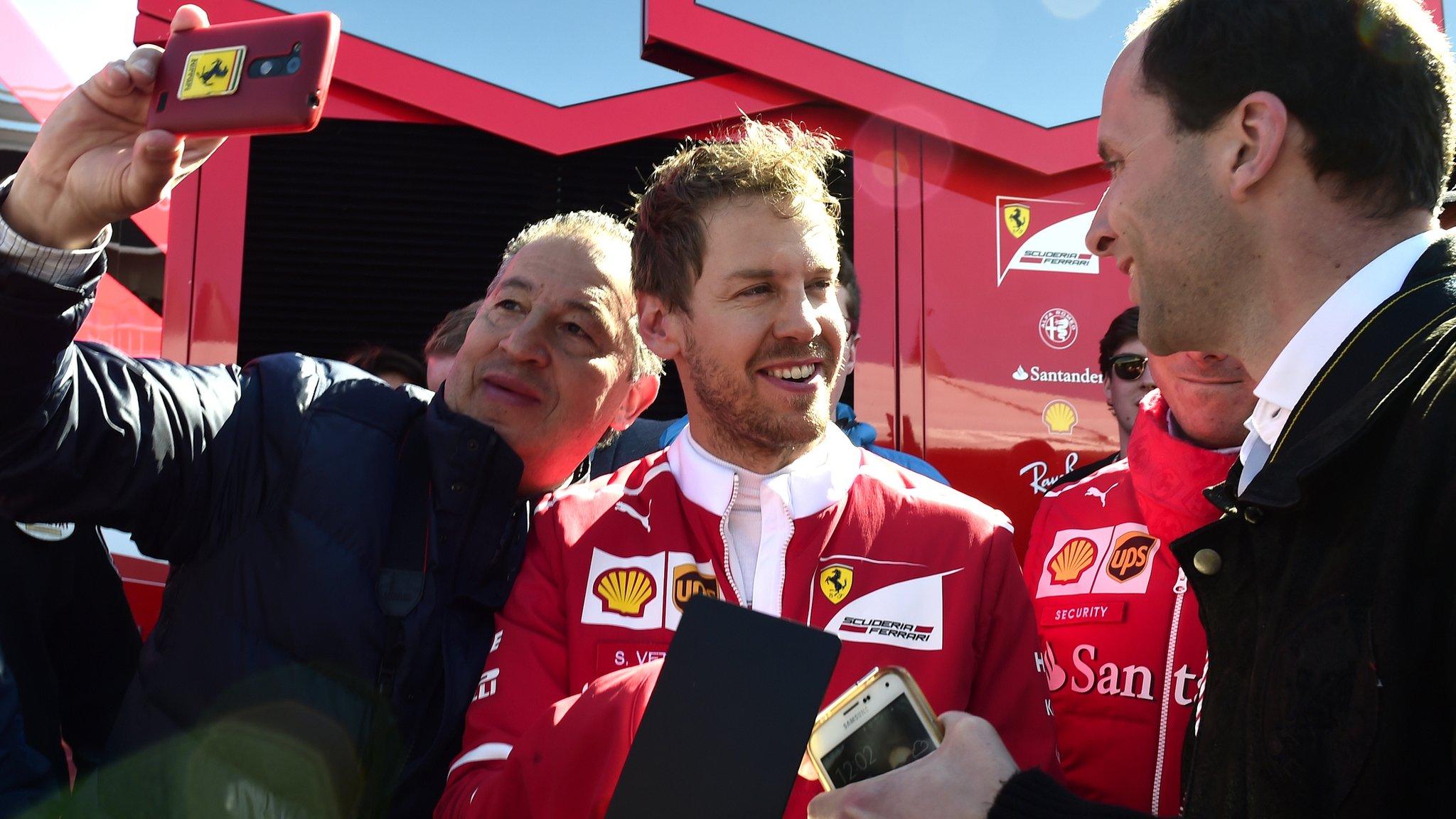Lewis Hamilton on F1 testing: 'The fastest I have ever been'
- Published

Ferrari were fastest on the final day of the first week of testing
The Formula 1 teams are halfway through their pre-season programmes following this week's test in Spain and it is just becoming possible to view shapes of the year to come.
The 2017 season heralds a revolutionary change to the cars, following rule changes aimed at making them deliberately faster for the first time in decades.
The drivers have been revelling in the higher cornering speeds and greater demands on their skills over four days at the Circuit de Barcelona-Catalunya this week.
And while trying to interpret form from testing is always fraught with risk, a sense of the competitive order is beginning to emerge, with promising signs for some famous names, and worrying ones for others.
The new cars
Lewis Hamilton could hardly contain his enthusiasm when it came to describing the sensation of driving his Mercedes this week.
"The car is amazing," the triple world champion said. "It is definitely the fastest I have ever been in F1."
The rules this year were aimed at bringing back a sense of edge and drama some felt the sport had lost in recent years. It means wider cars, with bigger tyres, and much more grip, creating faster cornering speeds, and much greater physical demands on the drivers.
"It is literally the downforce," Hamilton said, "how late and deep you can brake, how quickly you can get on the gas, how you are able to take corners flat out pretty easily.

"Turn Nine [a 160mph uphill right-hander], I am going out of it and I am like a kid on a rollercoaster ride because it is so much better than before.
"But it is worse to follow another car."
And there's the rub. It is possible - although by no means certain - that overtaking will be harder with these cars.
That's not a surprise - make cars faster through the corners and slower down the straight because of the drag from bigger tyres and bodywork, and it's inevitable that braking distances will be shorter. And generating more downforce potentially means there is more grip to lose when following another car, making it harder to get close to it.
Hamilton said this "magnifies the issue we had before". Others were not so sure, though. Both Red Bull's Max Verstappen and Renault's Nico Hulkenberg said they had been pleasantly surprised how easy they had found overtaking during the test.
"Well, I have done some," 19-year-old Verstappen said, in his matter-of-fact style. "So it is OK. It works; you can overtake with the car."
What about the tyres?
Pirelli seems to have succeeded in the mission it was set to provide tyres on which drivers can push hard for the duration of a stint, after six years in which the best in the world had to lap seconds off the pace in races to stop the tyres overheating. All drivers reported far less "degradation" than before, and the ability to push hard for much longer.
Pirelli was not specifically asked for tyres with low degradation. It was asked for tyres that did not irretrievably thermally degrade when stressed, and could be brought back by backing off slightly if they were over-worked; and degradation proportional to performance.
Palmer's guide to the new F1 cars
But team engineers said that Pirelli seemed to have responded to the requirements made of it by making harder tyres. One described them as "like concrete - they can push on them for 100 laps". And low 'deg' is what was generally being experienced in Barcelona.
Pirelli racing director Mario Isola admitted that the general feeling was that the tyre range was "a bit hard".
Hamilton confirmed this when he said he had been told by engineers that the tyres, on their own, were only 0.5 seconds quicker than last year's, despite being much wider.
A corollary of this could be fewer pit stops in races. Whether fewer pit stops is a bad thing is a matter of opinion, and in any case Pirelli should in theory be able to adjust it simply by bringing softer tyres to races.
And at least now spectators should be able to watch races and know drivers are doing what F1 is supposed to be about - pushing hard and being tested to their limits, rather than driving around slowly trying not to over-work four fragile pieces of rubber.
Which teams are at the front?
The fastest time of the test was set by a Mercedes, with a Ferrari second and a Red Bull third. So far, so 2016.
But headline lap times in testing are notoriously unreliable indicators of form because there are so many variables - fuel loads, engine modes, car spec, track condition, different times of day, temperature, tyre compound, etc.
Valtteri Bottas was quickest of all for Mercedes, using the 'ultra-soft' tyres. Ferrari did not use those tyres, Sebastian Vettel setting their fastest lap on the 'soft' tyre, 0.247 seconds slower than Bottas.
The lap-time difference between soft and ultra-soft would be expected to be much bigger than that, but the off-set between tyre compounds varied between teams and from day to day. So it is best to avoid trying to correct for that at this stage.
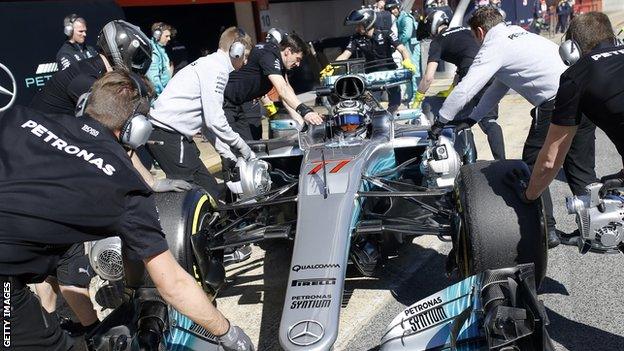
Mercedes are looking reliable. And quick
Using the 'soft' tyres, the Finn was 0.155secs slower than Vettel but on a run that was one lap longer.
On that basis, the Mercedes and Ferrari appeared pretty even in Spain - and certainly rival teams were impressed by the Italian car's pace.
"The Ferrari is very surprising," said McLaren racing director Eric Boullier. "Maybe people were not expecting them to be matching Mercedes' lap times."
So, can Ferrari challenge Mercedes this year at last? The jury is out.
The caveat is that Ferrari looked consistently good in testing last year before a season in which they failed to win a single race - and Mercedes always look slower than they actually are because they run their engine further from the maximum than others, and probably more fuel as well.
Red Bull - powered by Renault engines - seemed a little off the other two top teams this week, but there are good signs there, too.
Renault has made a significant step forward with its engine, but was running it de-tuned. Even so, Verstappen was close to the top of the speed-trap times on Tuesday. The Dutchman said Mercedes still had a power advantage but added: "We are definitely catching up."

Verstappen and Red Bull are catching up. They are going to need to
The car was also running light on downforce - team insiders say a big aerodynamic upgrade will appear at next week's final test.
Before testing, the word from Red Bull was that they would have to wait until mid-season before they could challenge Mercedes. Hints are beginning to seep out from the team, though, that it might happen earlier than that.
Most expect the big three to be out on their own. Haas owner Gene Haas said they were "racing themselves". But the midfield battle between Force India, Renault, Toro Rosso, Haas and Williams could be intense.
"The rest of us are somewhat competitive," Haas said. "All of our times are within a second or so, and those guys are another second ahead of that. It is really a two-tiered competition, and it is intense where we are at."
A crisis and some drama
McLaren have had four dismal seasons - the last two with an under-powered Honda engine and the two before that with a Mercedes engine but an uncompetitive car.
They entered this season with hopes that a change in rules would allow them to close the gap to the front and compete at least for podiums, if not the occasional win. But the early signs are not good. At all.
McLaren's first two days in Spain were rendered virtually useless because of reliability problems, first with an oil-tank problem on Monday and then an engine failure on Tuesday.
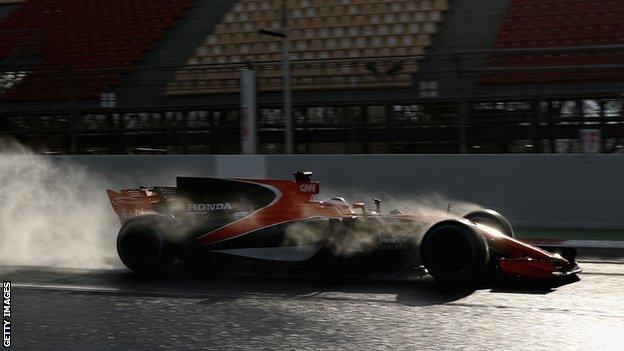
McLaren were slow. Too slow for Fernando Alonso, who was not happy
That was four engines used in two days. And although Honda has not been completely clear how many engines were used in total, it was at least five in four days.
The car ran more reliably over the final two days of the test but it was slow, although exactly how slow was hard to judge given Honda said the engine was not being run in its final specification.
The problems are clearly not all to do with Honda but a large part of them are - McLaren were slowest through the speed traps on the start-finish straight.
Fernando Alonso has not spoken to the media since Monday evening, when he said he was "disappointed and sad" but tried to put a positive spin on things as much as possible.
Racing director Eric Boullier admitted that the two-time champion was "not very happy" when the problems hit on Monday morning.
Who can blame him? Alonso went to McLaren to win the title, sold on the idea of reviving the glory days of the team's previous era with Honda, featuring Ayrton Senna and Alain Prost, in the late 1980s.
But that seems like a pipe dream at the moment.
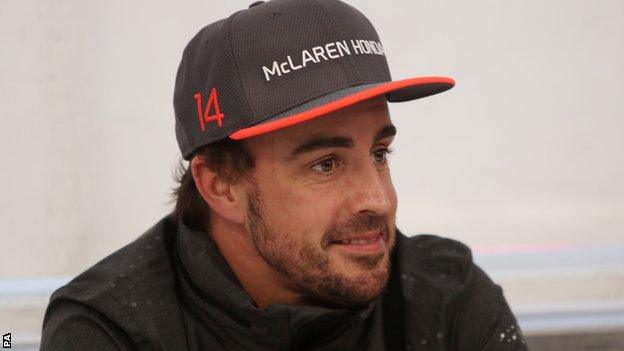
Alonso wears the smile of a man who really doesn't want to smile
Honda has designed a completely new engine for this season, copying the architecture of Mercedes, but sources say the Japanese turbo hybrid is way down on performance - the grapevine in Spain said it had less power at the moment than it had in 2015, Honda's first season back in F1.
It is hardly surprising, then, that questions are being raised about the sustainability of the McLaren-Honda partnership.
Boullier and Honda F1 boss Yusuke Hasegawa had to face inquiries on that basis from the media this week. Boullier said there was "no plan at all" to split. Hasegawa said: "Of course not."
Honda, in the third year of a 10-year contract with McLaren, provides in the region of a net $100m a year to the team compared to buying a customer engine - in the form of free engines, paying half the drivers' salaries and some sponsorship funds.
But if performance remains this poor, how long can McLaren risk staying with Honda before it does serious damage to the team? How long will Alonso's patience last?
And how long can Honda carry on in F1 before it decides its own reputation is at risk and it has to stop? Just as it did in 2008.
That decision was linked to the world financial crisis, as well as poor results. Now, Honda is facing a crisis of performance alone. How will it and McLaren react?
Best times for each team in first pre-season test
1 Mercedes (Valtteri Bottas) 1:19.705 ***
2 Ferrari (Sebastian Vettel) 1:19.952 *
3 Red Bull (Daniel Ricciardo) 1:21.153 *
4 Renault (Jolyon Palmer) 1:21.396 *
5 Sauber (Marcus Ericsson) 1:21.824 **
6 Haas (Romain Grosjean) 1:22.118 *
7 Williams (Felipe Massa) 1:22.076*
8 Force India (Esteban Ocon) 1:22.509 **
9 McLaren (Stoffel Vandoorne) 1:22.576 ***
10 Toro Rosso (Daniil Kvyat) 1:22.956 *
* = soft tyre; ** = super-soft tyre; *** = ultra-soft tyre
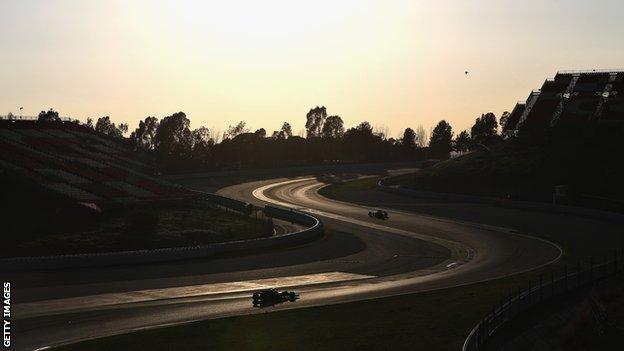
- Published2 March 2017

- Published1 March 2017
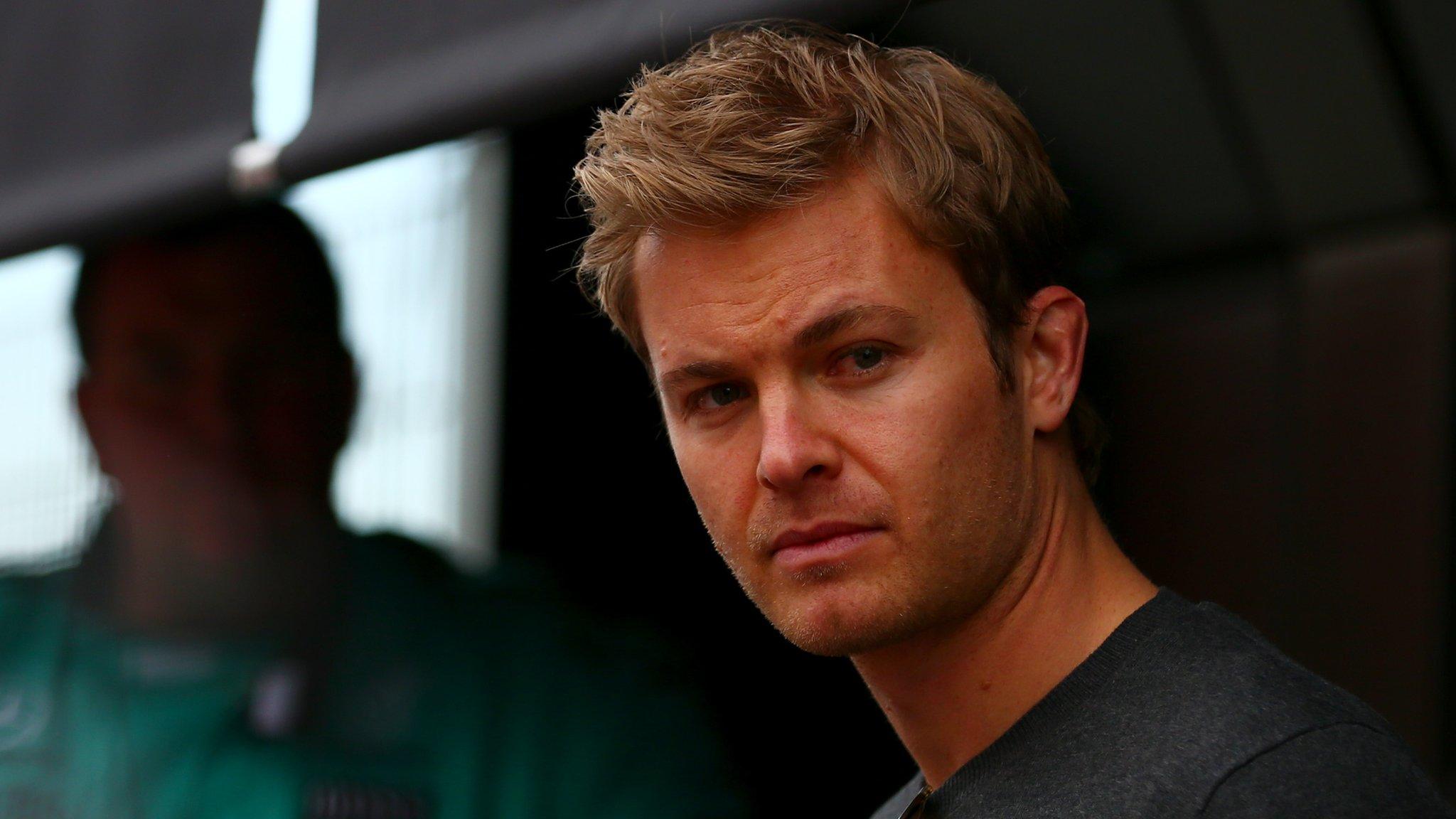
- Published27 February 2017
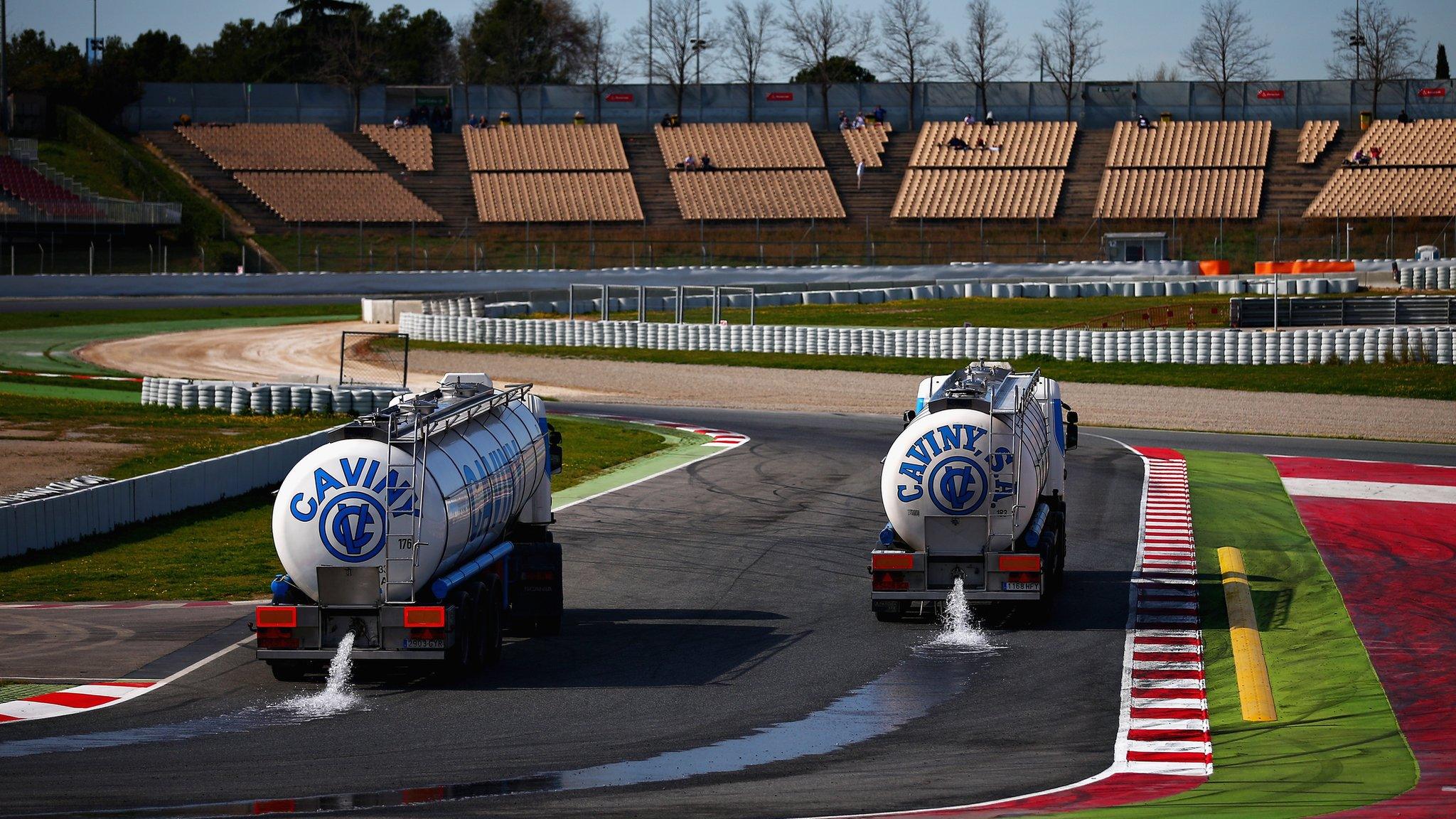
- Published1 March 2017
